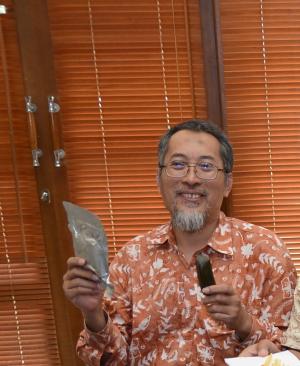Sterile Buras of IPB, the Disaster Emergency Food that Can Last up to Five Years Monday, March 02, 2015

Professor of the Faculty of Agricultural Technology, Bogor Agricultural University (Fateta IPB), Prof. Dr. Ir Sugiyono, MAppSc will present a scientific speech on Saturday (28/2) tomorrow, on the topic "Local-Based Development of Food Product". In a press conference held in IPB Baranangsiang campus of IPB before the oration, Thursday (26/2), Prof. Sugiyono said that the study he is engaged in is about the development of food products based on local raw materials.
"Food products made from local stuff we are developing are among others alternative products to rice such as instant corn and cassava granules, corn cookies and crackers, sweet potato noodles, sago noodles, and sterile buras. Of the many food products that we have developed, the sterile buras is an interesting product. It is intended as an emergency food or also potential as a commercial food product. It is developed to anticipate the occurrence of natural disasters," he said in front of dozens of the media members.
According to him, the solution to deal with food insecurity in emergency cases until today still relies on the supply of rice and noodles as food reserves. In the condition of the victim having trouble getting clean water, fuel and cooking utensils, the food aid in the form of rice or noodles are often unable to cope with food shortages quickly. This condition makes the provision of food aid (in the form of rice or noodles for disaster victims) less effective and less likely to be able to meet their food needs.
One way to overcome the problem of starvation after the disaster is by providing emergency food ready to eat for disaster victims. Ready-to-eat emergency food products already developed are usually in the form of calorie-rich biscuits. Biscuits are very practical as emergency food, but for the people of Indonesia, they cannot replace rice as a main food.
"Therefore, the emergency food for Indonesia should be made from the main ingredient of rice with the addition of vegetables and side dishes. We have been doing studies to produce an emergency food product in the form of a long-lasting sterile buras. This product is packed in aluminum foil for easy distribution," he added.
Results of the study by Prof. Sugiyono show that the sterile buras can be produced and it has a good acceptability. This is a wet food, the flavors of which can be made varied. It is also much like the daily diet containing rice, vegetables and side dishes.
The process of making sterile buras as emergency food principally has three stages: half-cooked buras, vacuum packaging, and pressurized heating (sterilization). Packaging is done in a vacuum condition (vacuum sealing). This is intended to prevent the product from swelling when heated.
Pressurized heating is the most important stage because it determines the sterility level of the product. It is to kill all microbes on the product and make it sterile. This process is done by using autoclaving at 121 degrees Celsius. The sterile buras can be stored at room temperature and has a shelf life of more than one year and even up to five years.
"Sterile buras can be made to weigh 100 grams per piece and packaged in aluminum foil containing two pieces of buras per pack (200 grams). Every adult requires the consumption of two packs of aluminum foil (400 grams) per serving. "Thus, in one-time consumption, the energy intake of 714.92 kcal can be obtained. Consumption of three times a day gives the intake of 2144.76 kilo calories", he said. (Mtd)



